欧盟ERP及美国能源之星要求
电视机各国能效要求

最大工作模式下的损耗 (A 的 最大工作模式下的损耗(A 的
单位以英寸表示)
单位以厘米表示)
Pmax=0.130*A+5
Pmax=0.020*A+5
Pmax=0.084*A+18
Pmax=0.013*A+18
Pmax=108
b. 睡眠模式损耗≤1.0W
2.2 测试条件
供电电压:
总谐波失真度: 环境温度: 湿度:
3.1 首先根据公式 1 计算出电视机的 PAEC(年预计能耗),保留小数点后一位。
PAEC = 0.365 × [(television avg on × 10) + (television passive × time passive) +
(television active × time active)]kWh/yr
北美/台湾 欧洲/澳洲/新西兰
中国 日本
115(±1%)Volts AC, 60Hz (±1%) 230(±1%)Volts AC, 50Hz (±1%) 220(±1%)Volts AC, 50Hz (±1%) 100(±1%)Volts AC, 50Hz (±1%)/60Hz(±1%) 注:产品功率大于 1.5KW 的,电压偏差可以是±4%
= 主动待机时间。
3.2 星级指数(SRI)
电视机的星级指数 SRI 通过公式 2 计算得出。
SRI=1 + log(CEC/BEC)/log(1-ERF) ………………………公式 2
注: SRI = 星级指数 Log = 10 为底的自然对数; CEC = 相对能耗 (每个型号的 CEC 应该是整数,单位是 kWh/yr. 不能小于 PAEC,可以大于 或等于 PAEC。 BEC = 通过公式 127.75 + 0.1825 x 屏幕面积(cm2)计算得出的基本能耗。 ERF = 星级因素,即是 20%或 0.2.
美国“能源之星”LED灯泡认证要求

LED灯泡(一体成型式)能源之星标准标准适用方:各生产商及分销商最新版本修订日期:2010年3月22日标准生效日期:2010年8月31日注:以下内容中“ LED灯泡(一体成型式)”简称为:LED灯泡承担的义务以下内容为能源之星合作协议的条款,涉及具有资质的LED灯泡的生产商和分销商能源之星成员必须坚持以下程序要求:●遵守现行能源之星资格标准、性能标准的定义,必须配合能源之星相关部门关于有权按照能源之星标准对产品进行第三方检测,检验合格后方可获准进行公开销售。
●遵守现行能源之星标识指南。
该指南描述了能源之星标志被如何使用。
成员必须遵循哪些准则以及确保所有相关的法定代表人,例如广告代理商、经销商、分销商都必须遵守这些准则。
●成员在申请LED灯泡认证的一年内必须至少有一款产品经检测合格或已经获得能源之星标志使用授权。
一旦上述通过,该成员即被认可。
当成员在做产品认证时,必须符合当时最新的认证标准。
●使用清晰且一一对应的带能源之星LED灯泡的标贴。
主要外包装物正面必须有能源之星证书标志,企业网站、产品目录、用户手册及技术规格参数表必须包含能源之星信息。
●成员必须每半年一次向能源之星组委会提供最新产品样本,并更新产品内容,包含任何产品的修改、检测数据的修改、产品型号或销售代码的变更、以及该产品将在一定时间内逐步终止生产或淘汰。
在此基础上,成员资格才可以被保持。
●如有任何供应商变化,包括新设备、新型号、新包装的信息变更,必须在30天以内以书面或在线等方式,告知具体的变化内容。
●对于每一类产品,必须提供官方认可的检测机构出具的符合能源之星产品性能标准的检测报告。
●每一个分类产品必须提供电子版或者复印件形式的包装样式报告,只有产品性能和包装检测结果均合格,才能进入合格产品目录。
●组委会将任意抽选某一成员的产品进行第三方检测,检测相关费用由成员承担,如成员拒绝接受检测,则其成员资格将被免除。
●每半年提交一次产品出货信息,特别是符合能源之星标准产品出货的总量,信息提交时应写明以下信息:灯头类型ANSI标准外形型号全向灯:A、BT、P、PS、S、T装饰灯:B、BA、C、CA、DC、F、G定向灯:BR、ER、K、MR、PAR、R非标准的:功率数产品编号(如果有)能源之星希望成员能主动提供出货总量信息及其中能源之星产品在总数中所占品种及百分比。
美国能源之星最新要求及企业应对策略
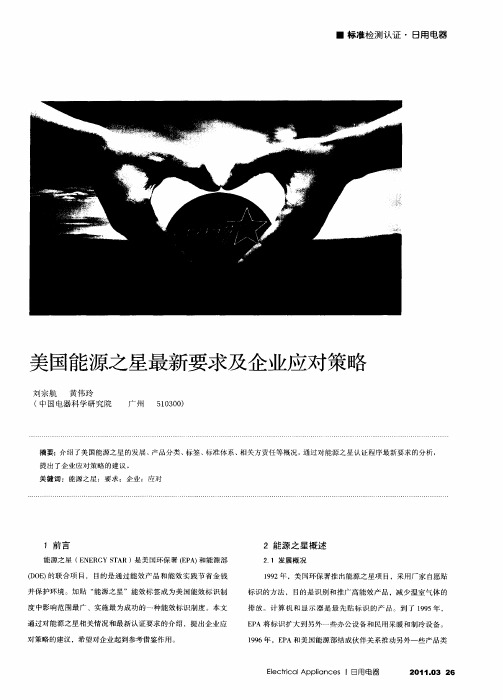
函件 中,表 明公司销售的产 品或服务达到能源之 星水平 ; 4) 作标志 ( atesi M r 合 P r rhp ak):用于促进组织 对能源之 n 星的承诺和合作关系 。
仅在 2 0 0 9年一年中,为商业单位 、各种机构和消费者共节 省大
家用及建筑维护 结构材料
约 10亿美元。在过 去的 l 中,能源之星已成为推动, 泛采 7 0年 用诸 如高效荧光照 明、办公设备 能源管理系统和低能耗待机 状 态等技术创新的力量 。 “ 能源之 星”标识 为 自愿性要求 ,但在节能管理 与能效标
证 机 构 也 可拥 有 自己的 实 验 室 。 ) 5)对 有 关 活 动 进 行 认 证 :在 E A 考 虑 某 种 产 品 是 否 可 获 P
1 )处 理和审批认可 机构 、实验室 和认证 机构的 申请 : 认 可机构 、实验 室和认证机构 向 E A提交 申请 ,E A审核并决定 P P
■ 标 准检 测 认证 ・日 用 电器
美 国能源之 星最新要求及企业应对 策略
刘 宗航 黄 伟 玲 ( 国 电器 科 学 研 究 院 中 广 州 5 0 0 ) 13 0
摘要:介绍 了美国能源之星的发展、产品分类、标签、标准体系、相关方责任等概 况,通过对能源 之星认证程序最新要求的分析
计 算 机 复印机 及传真机 计算机服务器 数 码 复 印 设 备 显 示 器 外 接 电 源 适配 器 打 印扫 描 一 体 机 、数 码 复 印机 照 明 产 品 装 饰 灯 带 /串 紧 凑 型 荧光 灯 (F ) C L 家 用 固 定 照 明装 置
能源之星标准

能源之星标准解读目前Kinfine公司要求其产品达到Energy Star要求,全面了解能源之星标准要求,对我们统一认识,明确今后任务,展开商务技术会谈有着重大意义,特对能源之星标准要求做详细翻译供大家参考如下:能源之星标准的框架:能源之星认证对LED产品的要求有两个层次:第一个层次:对所有产品的要求;第二个层次:分为两类1. 非标准产品;在包装和宣传材料商不能宣称相当于现存的多少瓦德标准产品;2. 替换型产品:目标为替换如下四类灯的产品;2.1. 目标为替代ANSI C79.1 2002标准里最顶的A, R, MR, PAR等等;2.2 目标为替代直径按照八分之一英寸计算的产品如A19,MR16, PAR38;2.3 目标为替代某种名义上瓦数的产品;2.4 目标为替代某种发光角度的定向性灯的产品能源之星标准的具体要求:4) 能源之星对所有产品的要求如下:4.1色温范围必须是ANSI C78. 377-2008 标准里所规定的2700K±145, 3000K±175,3500K±245,4000K±275 四个色温范围之一;4.2颜色保持率:色品度在6000小时的测试期间内,在CIE1976 (U’,V’)图内的变化不超过0.0074.3显色性:不低于80,R9必须大于0;4.4可调光性:必须在包装上对是否可调光做明确标识,如果能够调光,制造商必须有一个网页提供调光器的兼容信息;4.5质保期:从采购日起不小于三年;4.6灯头:必须是ANSI C81.61-2007标准里列明的灯头;4.7功率因素:>5W的产品功率因素必须大于等于0.70,<5W的产品功率因素不做要求;4.7.1操作温度:能在-20度,或者更低的温度下工作;4.7.2工作频率:大于等于150Hz;4.7.3电磁干扰:需要符合FCC 47 CFR PAR15标准;4.7.4瞬间保护:电源必须符合IEE C62.41-1991的Class A标准;4.7.5工作电压:AC120V, 240V, 277V 或者是AC或者DC 12V, 24V;5)包装方面的要求;6) 非标产品:在包装和宣传材料商不能宣称相当于现存的多少瓦德标准产品;2.1.1最低效率要求:10W以下必须达到50lm/W,10W以上必须达到55lm/W;2.1.2 最小光通量:200lm;2.1.3 发光强度分布:无特殊要求,需提供goniophotometry报告;2.1.4 光通维持率:25000小时工作后光通维持率不小于70%2.1.5 快速循环压力测试:参照ANSI C78.5 LM-65-01 2, 3, 5, 6条款7) 替代产品:替代产品的要求分为如下三种7A) 全方位灯包括ANSI C79 1-2002标准里的A, BT, P, PS, S, T型产品,要求如下:7A.1 最低效率要求:10W以下必须达到50lm/W,10W以上必须达到55lm/W;7A.2 最小光通量:替换20W 不小于200lm;替换35W 不小于325lm;替换40W 不小于450lm;替换60W 不小于800lm;替换75W 不小于1100lm;替换100W 不小于1600lm;7A.3发光强度分布:参考LM-79-08标准的Section10,产品必须有均匀的光分布,在0~135度内,任何角度的光强与平均光强的差别不能超过20%,至少有5%的光通量分布在135~180度角内等等要求;7A.4 产品最大直径:不超过ANSI C78.20-2003所规定的最大直径;7A.5 产品最大长度:不超过ANSI C78.20-2003所规定的最大直径;7A.6 光通维持率:25000小时工作后光通维持率不小于70%,参考LM-79-08;7A.7 快速循环压力测试:参照ANSI C78.5 LM-65-01 2, 3, 5, 6条款7B)装饰性灯包括ANSI C79 1-2002标准里的B, BA, C, CA, DC, F, G型产品,要求如下:7B.1 最低效率要求:40lm/W;7B.2 最小光通量:替换10W 不小于70lm;替换15W 不小于90lm;替换25W 不小于150lm;替换40W 不小于300lm;替换60W 不小于500lm;7B.3 产品最大直径:不超过ANSI C78.20-2003所规定的最大直径;7B.4 光通维持率:15000小时工作后光通维持率不小于70%,参考LM-79-08;7B.5 快速循环压力测试:参照ANSI C78.5 LM-65-01 2, 3, 5, 6条款7C) 定向性灯包括ANSI C79 1-2002标准里的BR, ER, K MR, PAR, R 等产品,要求如下:7C.1 定向性灯的定义是指80%的光集中在某一个角度内的产品;7C.2 最低效率要求:产品直径在20/8 英寸以上的必须达到40lm/W,产品直径在20/8 英寸以上的必须达到45lm/W,7C.3 颜色保持率:色品度在6000小时的测试期间内,在CIE1976 (U’,V’) 图内的变化不超过0.0077C.4 产品最大直径:不超过ANSI C78.20-2003所规定的最大直径;7C.5 产品最大长度:不超过ANSI C78.20-2003所规定的最大直径;7C.6 最小光输出:等于被替代灯所消耗瓦数*10;7C.7 PAR灯和MR16灯的中心光强要求:能源之星给出了一个网站,上面可以计算要求的最小中心光强;PAR灯:/htmlemail/energystar/dec09/eslntlampcenterbeamtool.zip MR16灯:/htmlemail/energystar/dec09/eslntlampcenterbeamtool.zip 7C.8 光通维持率:25000小时工作后光通维持率不小于70%,参考LM-79-08;7C.9 快速循环压力测试:参照ANSI C78.5 LM-65-01 2, 3, 5, 6条款能源之星关于光通维持率的要求如下:整灯测试6000小时,根据对应的光衰做寿命声明6000小时光通维持率允许-3%公差允许宣称的寿命装饰性灯最低要求86.70% 15000装饰性灯附加标准89.90% 20000非标准灯,全方向型灯最低要求,以及定向型,装饰型灯的选择性标准91.80% 2500093.1%% 3000094.1%% 3500094.8%% 4000095.4%% 45000所有类型灯选择性标准95.8%% 50000如果要宣称更长的寿命时间,按照以下标准:要求的最少测试时间测试完成后要求达到的最低光通维持率允许-3%公差允许宣称的寿命7500 91.20% 300008750 91.50% 3500010000 91.50% 4000012500 91.80% 45000 测试温度:非标准灯以及全方位型灯:10W以下的,测试温度为25度;非标准灯以及全方位型灯:10W以上的,测试温度为45度;装饰类的灯:25度;曾波2011-3-2。
显示器各国能效要求
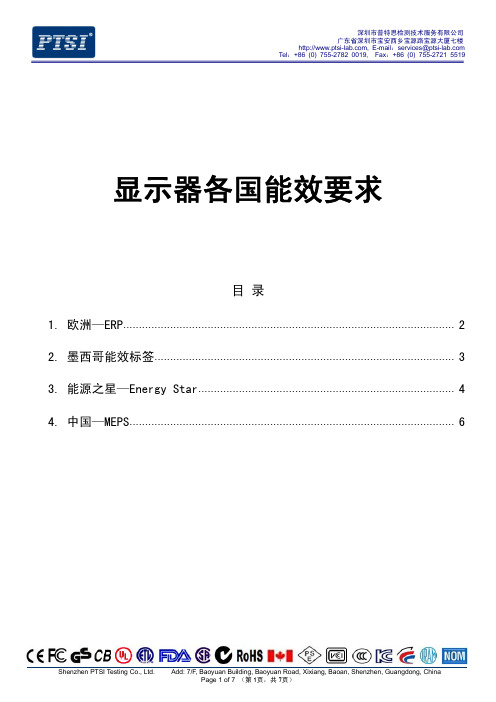
Shenzhen PTSI Testing Co., Ltd.
Add: 7/F, Baoyuan Building, Baoyuan Road, Xixiang, Baoan, Shenzhen, Guangdong, China Page 1 of 7 (第 1页,共 7页)
深圳市普特思检测技术服务有限公司 广东省深圳市宝安西乡宝源路宝源大厦七楼 , E-mail:services@ Tel:+86 (0) 755-2782 0019, Fax:+86 (0) 755-2721 5519
1. 欧洲—ERP
目前,根据 EC1275/2008, 欧盟针对显示器这类产品只有关机(off-mode)和待机(stand-by mode) 模式下的能耗要求,具体如下:
2008 年 12 月 17 日欧委会颁布法规 1275/2008, 自此法规强制实施一年后(2009 年 12 月 17 日): (1) 关机(off mode)模式下损耗:
3.1 显示器能耗的一般要求
a. 外置电源:如果显示器产品使用的是外置电源,那么外置电源需要符合 V 级能耗要求并标有 V 级标志。
b. 工作模式下的能耗要求
对于产品默认有自动亮度调节的,其工作模式下的功耗由公式 1 计算得出,要求小于或等于表 1 中公式计算出的最大功率损耗。
公式 1:用于计算有自动亮度调节的显示器正常工作损耗
深圳市普特思检测技术服务有限公司
广东省深圳市宝安西乡宝源路宝源大厦七楼 , E-mail:services@ Tel:+86 (0) 755-2782 0019, Fax:+86 (0) 755-2721 5519
3. 能源之星—Energy Star
能源之星
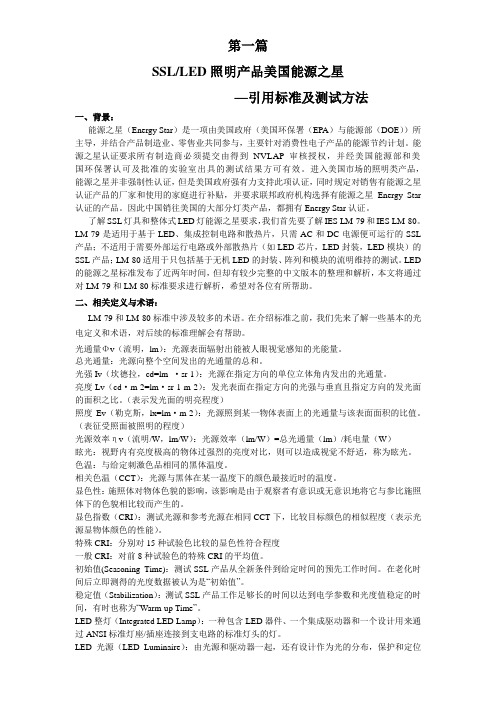
第一篇SSL/LED照明产品美国能源之星—引用标准及测试方法一、背景:能源之星(Energy Star)是一项由美国政府(美国环保署(EPA)与能源部(DOE))所主导,并结合产品制造业、零售业共同参与,主要针对消费性电子产品的能源节约计划。
能源之星认证要求所有制造商必须提交由得到NVLAP审核授权,并经美国能源部和美国环保署认可及批准的实验室出具的测试结果方可有效。
进入美国市场的照明类产品,能源之星并非强制性认证,但是美国政府强有力支持此项认证,同时规定对销售有能源之星认证产品的厂家和使用的家庭进行补贴,并要求联邦政府机构选择有能源之星Energy Star 认证的产品。
因此中国销往美国的大部分灯类产品,都拥有Energy Star认证。
了解SSL灯具和整体式LED灯能源之星要求,我们首先要了解IES LM-79和IES LM-80。
LM-79是适用于基于LED、集成控制电路和散热片,只需AC和DC电源便可运行的SSL 产品;不适用于需要外部运行电路或外部散热片(如LED芯片,LED封装,LED模块)的SSL产品;LM-80适用于只包括基于无机LED的封装、阵列和模块的流明维持的测试。
LED 的能源之星标准发布了近两年时间,但却有较少完整的中文版本的整理和解析,本文将通过对LM-79和LM-80标准要求进行解析,希望对各位有所帮助。
二、相关定义与术语:LM-79和LM-80标准中涉及较多的术语。
在介绍标准之前,我们先来了解一些基本的光电定义和术语,对后续的标准理解会有帮助。
光通量Φv(流明,lm):光源表面辐射出能被人眼视觉感知的光能量。
总光通量:光源向整个空间发出的光通量的总和。
光强Iv(坎德拉,cd=lm ·sr-1):光源在指定方向的单位立体角内发出的光通量。
亮度Lv(cd·m-2=lm·sr-1·m-2):发光表面在指定方向的光强与垂直且指定方向的发光面的面积之比。
欧盟通报真空吸尘器ErP及能标实施条例草案

之前提议的草案能效要求有所降低 ,
但仍 比即将 出台 的电视 机 6 . 0版能
欧盟 理事会 和欧洲 议会 的立法程 序
将会 展开 。鉴 于建议 规例将 影 响全 球工 业 ,预料 欧盟需 要颇 长时 间方
近 日 ,我 国 向 WT O秘 书处 正 式
源之星规范要求有显著的提高。
日用 电 器
禁 止在 家用冷 藏箱及冷 冻箱使 用氢
氟碳化物 ( HF C s ) ,2 0 2 0年前禁 止在 商用冷藏箱及 冷冻箱使用该等气体 。 氢氟 碳化 物是 很普遍 的含 氟温 室气体 类别 ,一般应 用于冷 藏 、空
2 0 1 2年 1 2月 1 7日, 欧 盟 向
WT O秘 书 处 分 别 通报 了 真 空 吸 尘 器 的 生 态 设 计 要 求 和 能 源 标 识 要 求 的
提交 了关于新 制定 的 电动 洗衣机 、
转速 可控型房 间空 气调节 器 、热泵
热水 机 、吸油 烟机 四类产 品强制性 国家 标准 。这 四类 家 电产 品强制性 国家 标准 拟 批 准 日期 为 WT O秘 书
处分发后 9 O天 ,拟 于 批 准 后 6个 月 生效 。
欧盟拟禁止在冷冻冷藏箱
使用氢氟碳化物
能议订及通过《 含氟温室气体规例 》
修订版 。
为 减少 含氟 温 室气体 排放 ,协 助 欧盟达 到气 候 目标 ,日前 ,欧洲 委员会建议修订法 例 ,于 2 0 1 5年前
欧盟通报真空吸尘器 E r Pቤተ መጻሕፍቲ ባይዱ
及能标 实施 条例草 案
国家 标 准 化 管 理 委 员会 ( S A C )
费 用 ,最低 的有锅 炉和火 炉的 1 9 % 和2 0 %,较 高 的有 吊扇 的 6 0 %、通
美国“能源之星”对办公设备的能效要求及应对措施的研究报告
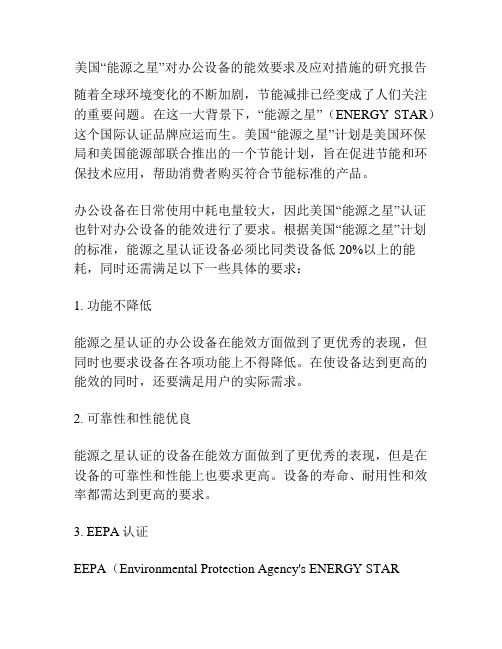
美国“能源之星”对办公设备的能效要求及应对措施的研究报告随着全球环境变化的不断加剧,节能减排已经变成了人们关注的重要问题。
在这一大背景下,“能源之星”(ENERGY STAR)这个国际认证品牌应运而生。
美国“能源之星”计划是美国环保局和美国能源部联合推出的一个节能计划,旨在促进节能和环保技术应用,帮助消费者购买符合节能标准的产品。
办公设备在日常使用中耗电量较大,因此美国“能源之星”认证也针对办公设备的能效进行了要求。
根据美国“能源之星”计划的标准,能源之星认证设备必须比同类设备低20%以上的能耗,同时还需满足以下一些具体的要求:1. 功能不降低能源之星认证的办公设备在能效方面做到了更优秀的表现,但同时也要求设备在各项功能上不得降低。
在使设备达到更高的能效的同时,还要满足用户的实际需求。
2. 可靠性和性能优良能源之星认证的设备在能效方面做到了更优秀的表现,但是在设备的可靠性和性能上也要求更高。
设备的寿命、耐用性和效率都需达到更高的要求。
3. EEPA认证EEPA(Environmental Protection Agency's ENERGY STARPurchasing)可支持组织节能采购计划,对于公共机构和企业,购买经过认证的能源之星设备有可能得到财政上的支持,同时也能为组织降低能耗费用。
根据美国“能源之星”计划的标准,针对办公设备的能效要求,我们建议企业应采取以下措施:1. 尽量使用能源之星认证的设备和器材,这些设备的能效更优秀,效率更高。
2. 科学合理的使用设备。
由于办公设备日常的用电量较大,企业需采取一些科学合理的措施来降低企业的能耗,如:在办公人员使用电脑时,可以合理设置电脑的屏幕亮度和待机时间;在没有使用时,可以把设备及时关闭,避免因长时间开启设备而导致的能量浪费。
3. 强化对企业员工的能效意识培养。
能源节约是全社会的责任,与个人行为有紧密的联系。
因此,在充分了解节能知识与技能的前提下,企业应加大对员工节能知识的培养,教育员工节能是件必须要做的事情。
关于认证问题回复

一、说说能源之星和ErP对LED灯泡的至少三个区别点?答:1、光效:①能源之星要求--灯功率P<10W ,灯光效≥50LM/W;灯功率P ≥10W ,灯光效≥55LM/W②ErP要求:最高光效为69LM/W2、显色指数:①能源之星要求--CRI≥80,R9>0。
②ErP要求:CRI≥803、寿命终止:①能源之星要求:初始光通量的70%为寿命终止时间②ErP要求:初始光通量的50%为寿命终止时间4、对象:①能源之星要求:针对所有LED灯。
②ErP要求:现在只针对非定向灯。
5、选用的标准:①能源之星要求:选用美国本土对LED灯泡标准。
②ErP要求:选用欧盟及国际电工委员会标准。
6、使用期限:①能源之星要求:使用3年后,需重新申请。
②ErP要求:产品不改变,则永久。
7、替代传统灯功率:两者略有偏差。
①能源之星要求:所有灯的光通量≥200LM。
②ErP要求:有可以替代15W传统灯。
8、标准要求:①能源之星要求:对能效能耗、电磁兼容要求;②ErP要求:对能效能耗和产品生命周期要求。
9、流明维持率:①能源之星要求:明确规定宣称寿命需要老化的时间和老化后达到的光通量维持率,达到的流明维持率要求②ErP要求:对6000h小时老化后所达到的等级分类10、能效:①能源之星要求:只对输出光通量要求。
②ErP要求:有明确的公式计算出能效等级。
二、说说UL和CE在LED照明产品至少两个共同点?答:1、异常测试内容相同;2、机械强度测试选用国际同一标准。
(两个不同的市场,选用标准和要求各不同,很难判断,唯有一些测试相同而已)三、一个LED射灯衰减过快的原因?答:1、LED灯珠的性能(选用的材料、芯片等);2、产品使用环境(温度、湿度等);3、产品外观散热设计(选用的材质、可散热途径);4、产品内置电源的转换性能(转换效率、电磁兼容性);5、LED灯珠、电源、散热设计之间的匹配性。
(主要考量材料之间热量的吸收与转换情况)。
专题一:EST,MEPS,ErP,欧洲能效标签,ELI,HK测试项目和区别

10
10
27
10
10
20
20
10
16
20
46
欧洲能效等级标签
20
/
澳洲MEPS
10
10
全球能效ELI
8
8
香港能效
20
10
英国EST
20
20
/
25
20
46
20
25
20
25
20
26
2009-12
6
能效认证之间的区别
流明维持率测试小时数(单位:小时)
老化小时数
100 1000 2000
美国能源之星 Energy Star
美国能源之星 ES
120V/60Hz
老化温度要求 15~35℃
美国加州能效 CEC 欧洲能效指令 ERP
欧洲能效等级标签 澳洲MEPS 全球能效ELI 香港能效 英国EST
120V/60Hz 额定值,若电压为一个
范围,则取中间值 同ERP 同ERP 同ERP
220V/50Hz
240V/50Hz
15~35℃ 15~40℃
15~40℃ 15~40℃ 15~40℃ 15~40℃ 15~40℃
2009-12
5
能效认证之间的区别
测试样品数量上 (单位:个,样品总数中包含备用样品的数量)
样品类型 美国能源之星 Energy Star 美国加州能效 CEC 欧洲能效指令 ERP
初始值 流明维持率 额定寿命测试 样品总数
10
3h on 20min off
√
10
能效认证之间的区别
Rapid Cycle Stress Test 开关循环次数要求上
美国能源之星的标准
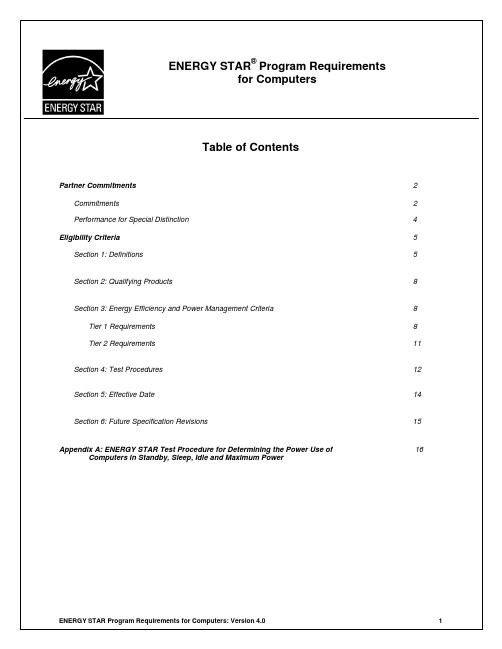
2. In product literature (i.e., user manuals, spec sheets, etc.);3. On product packaging for products sold at retail; and4. On the manufacturer’s Internet site where information about ENERGY STAR qualified models isdisplayed:− If information concerning ENERGY STAR is provided on the Partner Web site, as specified by the ENERGY STAR Web Linking Policy (this document can be found in the PartnerResources section on the ENERGY STAR Web site at ), EPA mayprovide links where appropriate to the Partner Web site;• agree to complete steps to educate users of their products about the benefits of power management by including the following information, in addition to that described in the User InformationRequirements found in the ENERGY STAR Eligibility Criteria (Section 3.A.3), with each computer (i.e., in the user manual or on a box insert):1. Energy saving potential;2. Financial saving potential;3. E nvironmental benefits4. Information on ENERGY STAR and a link to ; and5. ENERGY STAR logo (used in accordance with "The ENERGY STAR Identity Guidelines"available at /logos).In addition to the information contained with the product, the manufacturer will have similar information with a link to /powermanagement on the company Web site, readily accessible from computer product pages, product specifications, and related content pages.At the manufacturer’s request, EPA will supply suggested facts and figures related to the abovecriteria, template elements, or a complete template suitable for use in user guides or box inserts.EPA's goal is to achieve a 40% power management enabling rate nationally by 2010; 60% by 2012;and > 80% by 2014. EPA recognizes the importance of documenting enabling rates and encourages industry to develop a collective strategy for securing and funding this research, and sharing findings with EPA and the public.• provide to EPA, on an annual basis, an updated list of ENERGY STAR qualified computer models.Once the Partner submits its first list of ENERGY STAR qualified computer models, the Partner will be listed as an ENERGY STAR Partner. Partner must provide annual updates in order to remain on the list of participating product manufacturers;• provide to EPA, on an annual basis, unit shipment data or other market indicators to assist in determining the market penetration of ENERGY STAR. Specifically, Partner must submit the total number of ENERGY STAR qualified computers shipped (in units by model) or an equivalentmeasurement as agreed to in advance by EPA and Partner. Partner is also encouraged to provide ENERGY STAR qualified unit shipment data segmented by meaningful product characteristics (e.g., capacity, size, speed, or other as relevant), total unit shipments for each model in its product line, and percent of total unit shipments that qualify as ENERGY STAR. The data for each calendar yearshould be submitted to EPA, preferably in electronic format, no later than the following March and may be provided directly from the Partner or through a third party. The data will be used by EPA only for program evaluation purposes and will be closely controlled. Any information used will be masked by EPA so as to protect the confidentiality of the Partner;• notify EPA of a change in the designated responsible party or contacts for computers within 30 days.Performance for Special DistinctionIn order to receive additional recognition and/or support from EPA for its efforts within the Partnership, the ENERGY STAR Partner may consider the following voluntary measures and should keep EPA informed on the progress of these efforts:• consider energy efficiency improvements in company facilities and pursue the ENERGY STAR mark for buildings;• purchase ENERGY STAR qualified products. Revise the company purchasing or procurement specifications to include ENERGY STAR. Provide procurement officials’ contact information to EPA for periodic updates and coordination. Circulate general ENERGY STAR qualified product information to employees for use when purchasing products for their homes;• ensure the power management feature is enabled on all ENERGY STAR qualified monitors and computers in use in company facilities, particularly upon installation and after service is performed; • provide general information about the ENERGY STAR program to employees whose jobs are relevant to the development, marketing, sales, and service of current ENERGY STAR qualified productmodels;• provide a simple plan to EPA outlining specific measures Partner plans to undertake beyond the program requirements listed above. By doing so, EPA may be able to coordinate, communicate, and/or promote Partner’s activities, provide an EPA representative, or include news about the event in the ENERGY STAR newsletter, on the ENERGY STAR Web pages, etc. The plan may be as simple as providing a list of planned activities or planned milestones that Partner would like EPA to be aware of. For example, activities may include: (1) increase the availability of ENERGY STAR qualified products by converting the entire product line within two years to meet ENERGY STAR guidelines; (2) demonstrate the economic and environmental benefits of energy efficiency through special in-store displays twice a year; (3) provide information to users (via the Web site and user’s manual) about energy-saving features and operating characteristics of ENERGY STAR qualified products: and (4) build awareness of the ENERGY STAR Partnership and brand identity by collaborating with EPA on one print advertorial and one live press event;• provide quarterly, written updates to EPA as to the efforts undertaken by Partner to increase availability of ENERGY STAR qualified products, and to promote awareness of ENERGY STAR and its message.Below is the Version 4.0 product specification for ENERGY STAR qualified computers. A product mustF. D esktop-Derived Server: A desktop-derived server is a computer that typically uses desktopcomponents in a tower form factor, but is designed explicitly to be a host for other computers or applications. For the purposes of this specification, a computer must be marketed as a server and have the following characteristics to be considered a desktop-derived server:• Designed and placed on the market as a Class B product per EuroNorm EN55022:1998 under the EMC Directive 89/336/EEC and has no more than single processor capability (1 socket on board);• Designed in a pedestal, tower, or other form factor similar to those of desktop computers such that all data processing, storage, and network interfacing is contained within one box/product;• Designed to operate in a high-reliability, high-availability application environment where the computer must be operational 24 hours/day and 7 days/week, and unscheduled downtime is extremely low (on the order of hours/year);• Capable of operating in a simultaneous multi-user environment serving several users through networked client units; and• Shipped with an industry accepted operating system for standard server applications (e.g., Windows NT, Windows 2003 Server, Mac OS X Server, OS/400, OS/390, Linux, Unix andSolaris).Desktop-derived servers are designed to perform functions such as processing information for other systems, providing network infrastructure services (e.g., archiving), data hosting and running web servers.This specification does not cover mid-range or large servers, defined for purposes of thisspecification as:• Designed and placed on the market as a Class A product per EuroNorm EN55022:1998 under the EMC Directive 89/336/EEC and designed and capable of having a single or dualprocessor capability (1 or greater sockets on board);• Placed on the market as a Class B product, but hardware upgraded from a Class A product, per EuroNorm EN55022:1998 under the EMC Directive 89/336/EEC and designed capable of having a single or dual processor capability (1 or greater sockets on board); and • Designed and placed on the market as a Class B product per EuroNorm EN55022:1998 under the EMC Directive 89/336/EEC and designed and capable of having a minimum dualprocessor capability (2 sockets on board).G. Game Consoles: Stand alone computers whose primary use is to play video games. For thepurposes of this specification, game consoles must use a hardware architecture based on typical computer components (e.g., processors, system memory, video architecture, optical and/or hard drives, etc.). The primary input for game consoles are special hand held controllers rather than the mouse and keyboard used by more conventional computer types. Game consoles are also equipped with audio visual outputs for use with televisions as the primary display, rather than an external monitor or integrated display. These devices do not typically use a conventionaloperating system, but often perform a variety of multimedia functions such as: DVD/CD playback, digital picture viewing, and digital music playback.H. Integrated Computer: A desktop system in which the computer and display function as a singleunit which receives its ac power through a single cable. Integrated computers come in one of twopossible forms: (1) a system where the display and computer are physically combined into a single unit; or (2) a system packaged as a single system where the display is separate but is connected to the main chassis by a dc power cord and both the computer and display arepowered from a single power supply. As a subset of desktop computers, integrated computers are typically designed to provide similar functionality as desktop systems.I. Notebook and Tablet Computers: A computer designed specifically for portability and to beoperated for extended periods of time without a direct connection to an ac power source.Notebooks and tablets must utilize an integrated monitor and be capable of operation off an integrated battery or other portable power source. In addition, most notebooks and tablets use an external power supply and have an integrated keyboard and pointing device, though tablets use touch-sensitive screens. Notebook and tablet computers are typically designed to provide similar functionality to desktops except within a portable device. For the purposes of this specification, docking stations are considered accessories and therefore, the performance levels associated with notebooks presented in Table 1 of Section 3, below, do not include them.J. W orkstation: For the purposes of this specification, to qualify as a workstation, a computer must: • Be marketed as a workstation;• Have a mean time between failures (MTBF) of at least 15,000 hours based on either Bellcore TR-NWT-000332, issue 6, 12/97 or field collected data; and• Support error-correcting code (ECC) and/or buffered memory.In addition, a workstation must meet three of the following six optional characteristics:• Have supplemental power support for high-end graphics (i.e., PCI-E 6-pin 12V supplemental power feed);• System is wired for greater than x4 PCI-E on the motherboard in addition to the graphics slot(s) and/or PCI-X support;• Does not support Uniform Memory Access (UMA) graphics;• Includes 5 or more PCI, PCIe or PCI-X slots;• Capable of multi-processor support for two or more processors (must support physically separate processor packages/sockets, i.e., not met with support for a single multi coreprocessor); and/or• Be qualified by at least 2 Independent Software Vendor (ISV) product certifications; these certifications can be in process, but must be completed within 3 months of qualification. Operational ModesK. Idle State: For purposes of testing and qualifying computers under this specification, this is the state in which the operating system and other software have completed loading, the machine is not asleep, and activity is limited to those basic applications that the system starts by default.L. S leep Mode: A low power state that the computer is capable of entering automatically after a period of inactivity or by manual selection. A computer with sleep capability can quickly “wake” in response to network connections or user interface devices. For the purposes of this specification, Sleep mode correlates to ACPI System Level S3 (suspend to RAM) state, where applicable.M. Standby Level (Off Mode): The power consumption level in the lowest power mode which cannot be switched off (influenced) by the user and that may persist for an indefinite time when the appliance is connected to the main electricity supply and used in accordance with themanufacturer’s instructions. For purposes of this specification, Standby correlates to ACPISystem Level S4 or S5 states, where applicable.Networking and Power ManagementN. Network Interface: The components (hardware and software) whose primary function is to makethe computer capable of communicating over one or more network technologies. For purposes of testing to this specification, Network Interface refers to the IEEE 802.3 wired Ethernet interface. O. Wake Event: A user, programmed, or external event or stimulus that causes the computer totransition from Sleep or Standby to active mode of operation. Examples of wake events include, but are not limited to: movement of the mouse, keyboard activity, or a button press on the chassis, and in the case of external events, stimulus conveyed via a remote control, network, modem, etc. P. Wake On LAN (WOL): Functionality which allows a computer to wake from Sleep or Standbywhen directed by a network request.2) Qualifying Products: Computers must meet the computer definition as well as one of theproduct type definitions provided in Section 1, above, to qualify as ENERGY STAR. Please note that EPA will explore additional computer types, such as thin clients, for potential Tier 2requirements. The following table provides a list of the types of computers that are (and are not) eligible for ENERGY STAR.Products Covered by Version 4.0SpecificationProducts Not Covered by Version 4.0 Specification a. b. c. d. e. f. Desktop ComputersGame ConsolesIntegrated Computer SystemsNotebook Computers/Tablet PCsDesktop-Derived ServersWorkstations g. Mid-Range and Large Servers (as defined in Section 1F) h. Thin Clients/Blade PCs i. Handhelds and PDAs3) Energy Efficiency and Power Management Criteria: Computers must meet therequirements below to qualify as ENERGY STAR. Effective dates for Tier 1 and Tier 2 are covered in Section 5 of this specification.A) Tier 1 Requirements - Effective July 20, 2007(1) Power Supply Efficiency RequirementsComputers Using an Internal Power Supply: 80% minimum efficiency at 20%, 50%, and 100% of rated output and Power Factor > 0.9 at 100% of rated output.Computers Using an External Power Supply: Must be ENERGY STAR qualified or meet the no-load and active mode efficiency levels provided in the ENERGY STAR Program Requirements for Single Voltage Ac-Ac and Ac-Dc External Power Supplies. The ENERGY STAR specification and qualified product list can be found at /powersupplies . Note: This performance requirement also applies to multiple voltage output external power supplies as tested in accordance to the Internal Power Supply test method referenced in Section 4, below.(2) Operational Mode Efficiency RequirementsDesktop Categories for Idle Criteria: For the purposes of determining Idle state levels, desktops (including integrated computers, desktop-derived servers and game consoles) must qualify under Categories A, B, or C as defined below:Category A: All desktop computers that do not meet the definition of either Category B orCategory C below will be considered under Category A for ENERGY STAR qualification.Category B: To qualify under Category B desktops must have:•Multi-core processor(s) or greater than 1 discrete processor; and•Minimum of 1 gigabyte of system memory.Category C: To qualify under Category C desktops must have:•Multi-core processor(s) or greater than 1 discrete processor; and• A GPU with greater than 128 megabytes of dedicated, non-shared memory.In addition to the requirements above, models qualifying under Category C must be configured with a minimum of 2 of the following 3 characteristics:•Minimum of 2 gigabytes of system memory;•TV tuner and/or video capture capability with high definition support; and/or•Minimum of 2 hard disk drives.Notebook Categories for Idle Criteria: For the purposes of determining Idle state levels, notebooks and tablets must qualify under Categories A or B as defined below:Category A: All notebook computers that do not meet the definition of Category B below will be considered under Category A for ENERGY STAR qualification.Category B: To qualify under Category B notebooks must have:• A GPU with a minimum of 128 megabytes of dedicated, non-shared memory.Workstation Levels: Workstation levels will be determined using a simplified Typical Electricity Consumption (TEC) approach to allow manufacturers energy trade offs between different operating modes, based on a given weighting factor for each mode. The final level will be based on the TEC power level (P TEC) which will be determined by the following formula:P TEC = 0.1 * P Standby + 0.2 * P Sleep + 0.7 * P Idlewhere, P Standby is the power measured in Standby, P Sleep is the power measured in Sleep, and in P Idle is the power measured in Idle. This P TEC value will then be compared to the TEC budget which is determined by a fixed percentage of the maximum power of the system, including an adder for installed hard drives as indicated in the equation in Table 1. The test procedure for determining the maximum power of workstations can be found in Section 4 of Appendix A.Power Level Requirements: The following tables indicate the required power allowances for the Tier 1 specification. Table 1 gives the baseline requirements, while Table 2 gives additional power allowances for WOL. For those products that meet the WOL enabling requirement for either Sleep or Standby, a model must meet the energy level provided in Table 1 summed with the appropriate allowances from Table 2. Note: Products whose Sleep levels meet the Standby power requirements do not need to have a distinct Standby (Off mode), and may qualify for this specification using only Sleep mode.Table 1: Tier 1 Energy Efficiency Requirements Product Type Tier 1 RequirementsDesktops, Integrated Computers, Desktop-Derived Servers and GamingConsoles Standby (Off Mode): ≤ 2.0 WSleep Mode: ≤ 4.0 WIdle State:Category A: ≤ 50.0 WCategory B: ≤ 65.0 WCategory C: ≤ 95.0 WNote: Desktop-derived servers (as defined in section 1. F) are exempt from the Sleep level above.Notebooks and Tablets Standby (Off Mode): ≤ 1.0 W Sleep Mode: ≤ 1.7 WIdle State:Category A: ≤ 14.0 WCategory B: ≤ 22.0 WWorkstations TEC Power (P TEC):≤ 0.35 * [P Max + (# HDDs * 5)] WNote: Where P max is the maximumpower drawn by the system as testedper the test procedure in Section 4 ofAppendix A, and #HDD is the number of installed hard drives in the system.Table 2: Tier 1 Capability Adder for Sleep and StandbyCapability Additional Power Allowance Wake On LAN (WOL) + 0.7 W for Sleep+ 0.7 W for StandbyQualifying Computers with Power Management Capabilities: The following requirements should be followed when determining whether models should be qualified with or without WOL:Standby: Computers should be tested and reported as shipped for Standby. Models that will be shipped with WOL enabled for Standby should be tested with WOL enabled and will qualify using the extra allowance for Standby found in Table 2 above. Likewise, products shipped with WOL disabled for Standby must be tested with WOL disabled and must meet the baseline requirement for Standby found in Table 1.Sleep: Computers should be tested and reported as shipped for Sleep. Models sold through enterprise channels, as defined in the Tier 1 Power Management Requirements (Section 3.A.3), shall be tested, qualified, and shipped WOL enabled. Products going directly to consumers through normal retail channels are not required to be shipped with WOL enabled from Sleep, and may be tested, qualified, and shipped with WOL either enabled or disabled. Those models soldboth through enterprise channels and directly to consumers must test and meet both the levelswith and without WOL.Systems where any additional management services are, at the customer’s request, pre-provisioned by the manufacturer, do not need to test the systems with these functions in an active state providing the function is not actually activated until there is specific action by the end user (i.e., manufacturer should test in pre-provisioned state and does not have to consider the power use after full provisioning occurs on site).(3) Power Management RequirementsShipment Requirement: Products must be shipped with the display’s Sleep mode set to activate within 15 minutes of user inactivity. All products, except for desktop-derived servers which are exempt from this requirement, must be shipped with a Sleep mode which is set to activate within 30 minutes of user inactivity. Products may have more than one low power mode but these proposed criteriaaddress Sleep mode as defined in this specification. Computers shall reduce the speed of any active1 Gb/s Ethernet network links when transitioning to Sleep or Standby.All computers, regardless of distribution channel, shall have the ability to enable and disable WOL for Sleep mode. Systems shipped through enterprise channels must have Wake On LAN (WOL) enabled from the Sleep mode when operating on ac power (i.e. notebooks may automatically disable WOL when operating on their portable power sources). For the purpose of this specification, “enterprise channels” are defined as sales channels normally used by large and medium-sized business,government organizations, and educational institutions, with the intent of identifying machines that will be used in managed client/server environments. For all computers with WOL enabled any directed packet filters shall be enabled and set to an industry standard default configuration. Until one (or more) standards are agreed upon, partners are asked to provide their direct packet filter configurations to EPA for publication on the Website to stimulate discussion and development of standardconfigurations. Systems in which the Sleep mode maintains full network connectivity, providing the same fully connected network state found in Idle, can be considered to meet the WOL enablingrequirement and may qualify using the corresponding WOL capability adder.All machines shipped to enterprise customers shall be capable of both remote and scheduled wake events from Sleep mode. Manufacturers shall ensure, where the manufacturer has control (i.e.,configured through hardware settings rather than software settings), that these settings can bemanaged centrally, as the client wishes, with tools provided by the manufacturer.User Information Requirement: In order to ensure that purchasers/users are properly informed on the benefits of power management, the manufacturer will include with each computer, one of the following:• Information on ENERGY STAR and the benefits of power management in either a hard copy or electronic copy of the user manual. This information should be near the front of the user guide; or • A package or box insert on ENERGY STAR and the benefits of power management.Either option must at least include the following information:• Notice that the computer has been shipped enabled for power management and what the time settings are; and• How to properly wake the computer from Sleep mode;(B) Tier 2 Requirements - Effective January 1, 2009(1a) Tier 2 Energy Efficiency Performance Metric. All computers will be required to meet thefollowing minimum performance per unit energy metric:Energy Efficiency Performance Software and Associated Levels: TBD- OR -(1b) Provisional Tier 2 Idle State Requirements. If an energy efficiency performance metric and associated performance levels are not ready to go into effect by January 1, 2009, a provisional Tier 2 specification will automatically go into effect and will remain in effect until such a benchmark isestablished. This provisional Tier 2 will include revised Idle state levels for all computer types (those included in Tier 1 as well as others as appropriate [e.g., thin clients]) with the intention of capturing the top 25% performers in energy efficiency.Additional topics, including the following, will also be re-examined under a provisional Tier 2:• Idle levels for notebooks and integrated computers that incorporate the energy use of the displays;• Quantitative distinctions between desktop categories (e.g., megabytes of video memory, number of processor cores, megabytes of system memory) to ensure that these distinctions remaincurrent;• Sleep levels for desktop-derived servers; and• Allowances for additional management tools, such as service processors in Sleep and Standby, which may aid in the adoption of computer power management.In the case of the implementation of a provisional Tier 2, EPA and the European Commission will reexamine these new topics and finalize new levels at least six months prior to the effective date for Tier2.(2) Power Management Requirements: In addition to the requirements provided under Tier 1,above, ENERGY STAR qualified computers must maintain full network connectivity while in Sleep mode, according to a platform-independent industry standard. All computers shall reduce theirnetwork link speeds during times of low data traffic levels in accordance with any industry standards that provide for quick transitions among link rates.C) Voluntary RequirementsUser Interface: Although not mandatory, manufacturers are strongly recommended to designproducts in accordance with the Power Control User Interface Standard — IEEE 1621 (formally known as “Standard for User Interface Elements in Power Control of Electronic Devices Employed inOffice/Consumer Environments”). Compliance with IEEE 1621 will make power controls moreconsistent and intuitive across all electronic devices. For more information on the standard see/Controls.4) Test Procedures: Manufacturers are required to perform tests and self-certify those models thatmeet the ENERGY STAR guidelines.• In performing these tests, partner agrees to use the test procedures provided in Table 3, below.• The test results must be reported to EPA or the European Commission, as appropriate.Additional testing and reporting requirements are provided below.A. Number of Units Required for Idle Testing: Manufacturers may initially test a single unit forqualification. If the initial unit tested meets the maximum power level for Idle but falls within 10% of that level, one additional unit of the same model with an identical configuration must also be tested. Manufacturers shall report Idle values for both units. To qualify as ENERGY STAR, both units must meet the maximum Idle level for that product category. Note: This additional testing is only required for Idle qualification – only one unit is required to be tested for Sleep and Standby.The following example further illustrates this approach:Category A desktops must meet an Idle level of 50 watts or less, making 45 Watts the 10%threshold for additional testing. The following scenarios could then occur when testing amodel for qualification:• If the first unit is measured at 44 watts, no more testing is needed and the model qualifies (44 watts is 12% more efficient than the specification and is therefore “outside” the 10%threshold).• If the first unit is measured at 45 watts, no more testing is needed and the model qualifies (45 watts is exactly 10% more efficient than the specification).• If the first unit is measured at 47 watts, then an additional unit must be tested to determine qualification (47 Watts is only 6% more efficient than the specification and is “within” the 10% threshold).• If the two units are then tested at 47 and 51 watts, the model does not qualify as ENERGY STAR—even though the average is 49 watts— because one of the values (51) exceeds theENERGY STAR specification.• If the two units are then tested at 47 and 49 watts, the model does qualify as ENERGY STAR because both values meet the ENERGY STAR specification of 50 watts.B. Models Capable of Operating at Multiple Voltage/Frequency Combinations: Manufacturers shalltest their products based on the market(s) in which the models will be sold and promoted asENERGY STAR qualified. EPA and its ENERGY STAR Country Partners have agreed upon a table with three voltage/frequency combinations for testing purposes. Please refer to the Test Conditions in the Test Procedure (Appendix A) for details regarding internationalvoltage/frequency combinations for each market.For products that are sold as ENERGY STAR in multiple international markets and, therefore, rated at multiple input voltages, the manufacturer must test at and report the required powerconsumption or efficiency values at all relevant voltage/frequency combinations. For example, a manufacturer that is shipping the same model to the United States and Europe must measure, meet the specification, and report test values at both 115 Volts/60 Hz and 230 Volts/50 Hz in order to qualify the model as ENERGY STAR in both markets. If a model qualifies as ENERGY STAR at only one voltage/frequency combination (e.g., 115 Volts/60 Hz), then it may only be qualified and promoted as ENERGY STAR in those regions that support the tested voltage/frequencycombination (e.g., North America and Taiwan).Table 3: Test Procedures for Measuring Operational Modes SpecificationRequirementTest Protocol SourceStandby (Off Mode), Sleep Mode, Idle State and Maximum Power ENERGY STAR ComputerTest Method (Version 4.0)Appendix A。
美国“能源之星”LED灯泡认证要求

美国“能源之星”LED灯泡认证要求随着能源环保意识的日益提高,节能减排成为当前全球关注的重要议题之一。
为了推广和普及高效的LED照明技术,美国能源部(DOE)引入了“能源之星”计划,以认证符合要求的LED灯泡,促进市场上的可持续发展。
本文将介绍“美国能源之星”LED灯泡认证的相关要求及意义。
一、“能源之星”计划“能源之星”计划是美国能源部推出的一项促进节能减排的计划。
该计划旨在提高能源使用效率和减少温室气体排放,以支持可持续发展。
其中,LED照明技术是被广泛推广的可持续替代方案之一。
通过推广LED照明技术,可以大幅度降低电费开支和碳排放量,同时提高灯具的寿命。
因此,“能源之星”计划特别推出LED灯泡认证标准,以推广LED照明技术,引导消费者选购符合标准的LED灯泡,从而切实实现节能减排的目标。
二、“能源之星” LED灯泡认证的要求1.光通量、功率和效果LED灯泡主要的性能指标是光通量、功率和效率。
美国能源部规定,符合标准的LED灯泡必须要有高光通量,即要求灯泡能够达到一定光线照度,并且需要在标准的电压下使用,保证其正常工作。
同时,灯泡的功率每瓦特需要达到一定的标准,当前要求的最小功率为4.5瓦。
最后,效果也是LED灯泡认证的要求之一,即灯泡要有良好的光均匀度,能够满足目的地使用的不同需求,提供较好的照明效果。
2.灯泡外观和尺寸除了光通量、功率和效率外,LED灯泡的外观和尺寸也是认证的重要因素之一。
具体来说,LED灯泡需要与常规灯泡的外观和尺寸相似,以方便其在现有的灯具中更换。
例如,LED 灯泡需要与传统灯泡的口径和长度相似,从而使其在现有的灯具中可以很好地使用。
3.可靠性和寿命LED灯泡的可靠性和寿命也是认证的重要因素之一。
由于LED的使用寿命受到许多因素的影响,例如温度和电压等,因此,美国能源部制定了一些严格的测试标准,以测试灯泡的可靠性和寿命。
这些测试包括白炽灯的等效寿命测试和LED灯泡用于暴露温度的测试等,以确保灯泡的可靠性和寿命符合标准。
显示器各国能效要求

表 1:工作模式下最大损耗的计算要求(PON ) MAX
产品类别
屏幕对角线尺寸 屏幕像素 (百
(英寸单位)
万单位)
d<30.0 30.0≤d≤60.0
r≤1.1 R>1.1
Any
c. 睡眠模式损耗≤2.0W
PON MAX 1 阶段 (watts)
注解: ·r=屏的像素(百万为单位) ·A=可视的屏面积(英寸为单位,小数点后 1 位) (6.0×r)+(0.05×A)+3.0
4. 中国—MEPS
4.1 显示器能效等级 显示器能效等级分为 3 级,其中 1 级能效最高。各等级显示器的能源效率应不低于表 1 的规定,
关闭状态能耗应不大于表 1 的规定。
表 1 显示器能耗等级
显示器类型
CRT LCD
1级
能源效率 /(cd/W)
关闭状态能 耗/W
0.18
1
1.05
0.5
a. 显示器单位时间能耗的计算
(9.0×r)+(0.05×A)+3.0
(0.27×A)+8.0
Shenzhen PTSI Testing Co., Ltd.
Add: 7/F, Baoyuan Building, Baoyuan Road, Xixiang, Baoan, Shenzhen, Guangdong, China Page 4 of 7 (第 4页,共 7页)
用于计算有自动亮度调节的显示器正常工作损耗是显示器工作在最高环境照度300勒克斯条件下测到的功率是显示器工作在最小环境照度0勒克斯条件下测到的功率对于没有亮度自动调节或自动亮度调节为非默认的显示器产品工作模式下的损耗可以遵照能源之星测试方法计算得出需要小于或等于根据表1中计算出来的最大损耗值
能源之星的要求

CFLs合伙人协议的ENERGY STAR 适用标准应用单位:CFLs(紧凑型荧光灯)的生产商和分销商协议:以下为ENERGY STAR(能源之星)合作协议的条款,适用于ENERGY STAR 合格的CFLS的生产和/或交付。
ENERGY STAR的合伙人必须遵循以下要求:遵循现有的ENERGY STAR合格标准(阐述了在CFLS上使用ENERGY STAR认证标记和CFLS测试标准必须符合性能标准)。
这些产品可能在市面上获得,或应DOE(能源部)的要求,由合伙人自愿提供。
遵循现有的ENERGY STAR鉴定指导(描述了如何使用ENERGY STAR标记和名称)。
合伙人应遵守这些指南并且为确保合格机构(如广告商、经销商和分销商)符合此要求。
凡ENERGY STAR合格的CFL型号,在协议中CFL部分的1年有效期内进行鉴定或打标。
当合伙人证明产品合格时,产品必须符合当时的标准。
一旦合伙人递交了首次合格型号给ENERGY STAR,合伙人组织名称须作为ENERGY STAR合伙人()列出。
提供ENERGY STAR合格的CFLS标签。
ENERGY STAR认证标志应清晰的显示在合格产品包装上,在合伙人的网站上和合格产品的文字说明中(即目录,说明书,产品规格等等)。
给出其ENERGY STAR合格的产品型号。
同时要求ENERGY STAR认证标记在合格产品的包装正面标记。
在DOE季刊上,列出ENERGY STAR合格CFLs的更新清单。
合伙人如更新合格CFLS型号的试验数据或报告,修订型号和/或产品号,应及时通知DOE。
合伙人应提供季刊以列明ENERGY STAR CFL合伙人的清单;如合格专用标签CFLs的指定供应商有改变,应在30天内通知DOE。
要求合伙人书面提供更新专用标签供应商资格表(确定新的原始设备生产商、型号、和其他包装信息);提供合格CFL型号测试数据报告(由合格试验室提供)给DOE,证明荧光灯符合规定的安全和性能试验标准;提供合格CFL型号的产品包装样品(包括电子或硬拷贝)给DOE,证明荧光灯符合包装要求。
各国安规标准与能源之星标准
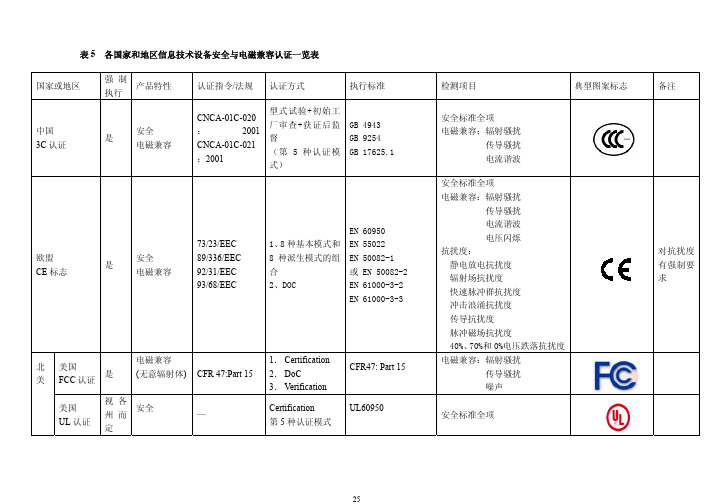
EU Eco-Label
GEEA
美国
Energy Star
日本
Exec.Orde Eco Mark r/FEMP
挪 丹 冰 芬 瑞 德国 威麦岛兰典
TOP Nordic Swan
Blue Angel
Runn
er
韩国
Energy Saving
产品
显示器 睡眠模 睡 眠 模 睡 眠 模 3 W 式 15 式 15 式 15
W /W /W / 深睡眠 深 睡 眠 深 睡 眠
模 式 模式 8 模式 8
8W W
W
关 机 模 式: 1 睡眠模式 1 W
W
15 W /
深睡眠模
式 8W
打印机
15 W / 30 W / 45 W
15 W / 30 W / 45 W
15 W / 30 W / 45 W
3 W - 15 W / 15 W / 1 W
安全标准全项 电磁兼容:辐射骚扰
传导骚扰 电流谐波
安全标准全项 电磁兼容:辐射骚扰
传导骚扰 电流谐波 电压闪烁 抗扰度: 静电放电抗扰度 辐射场抗扰度 快速脉冲群抗扰度 冲击浪涌抗扰度 传导抗扰度 脉冲磁场抗扰度 40%、70%和 0%电压跌落抗扰度 电磁兼容:辐射骚扰 传导骚扰 噪声
安全标准全项
备注
30
表 5 各国家和地区信息技术设备安全与电磁兼容认证一览表
国家或地区
中国 3C 认证
强制 产品特性
执行 安全
是 电磁兼容
认证指令/法规 认证方式
执行标准
CNCA-01C-020
:
2001
CNCA-01C-021 :2001
型式试验+初始工 厂审查+获证后监 督 (第 5 种认证模 式)
能源之星要求
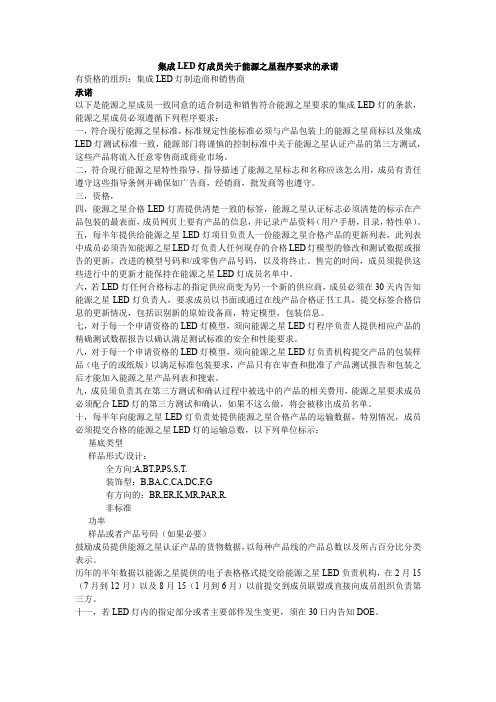
必须为灯配一份保修单,至少包括至购买之日其三年内的原料维修和零件替
换
必须是 ANSI 列出的灯座之一 ANSI
自检
C81.61-2007
对于功率小于 5W 和低压灯 ANSI
具,无此要求,大于 5W,功 C82.77-2002
率因数须大于 0.70.
色容差一致
C78-377-2008
标 准实 际实 际
CCT
CCT 和 DUV 和
容差
容差
2700K 2725 ± 0.000 ±
145
0.006
3000K 3045 ± 0.000 ±
175
0.006
3500K 3465 ± 0.000 ±
245
0.006
4000K 3985 ± 0.001 ±
275
集成 LED 灯成员关于能源之星程序要求的承诺 有资格的组织:集成 LED 灯制造商和销售商 承诺 以下是能源之星成员一致同意的适合制造和销售符合能源之星要求的集成 LED 灯的条款, 能源之星成员必须遵循下列程序要求: 一,符合现行能源之星标准,标准规定性能标准必须与产品包装上的能源之星商标以及集成 LED 灯测试标准一致,能源部门将谨慎的控制标准中关于能源之星认证产品的第三方测试, 这些产品将流入任意零售商或商业市场。 二,符合现行能源之星特性指导,指导描述了能源之星标志和名称应该怎么用,成员有责任 遵守这些指导条例并确保如广告商,经销商,批发商等也遵守。 三,资格, 四,能源之星合格 LED 灯需提供清楚一致的标签,能源之星认证标志必须清楚的标示在产 品包装的最表面,成员网页上要有产品的信息,并记录产品资料(用户手册,目录,特性单)。 五,每半年提供给能源之星 LED 灯项目负责人一份能源之星合格产品的更新列表,此列表 中成员必须告知能源之星 LED 灯负责人任何现存的合格 LED 灯模型的修改和测试数据或报 告的更新,改进的模型号码和/或零售产品号码,以及将终止、售完的时间,成员须提供这 些进行中的更新才能保持在能源之星 LED 灯成员名单中。 六,若 LED 灯任何合格标志的指定供应商变为另一个新的供应商,成员必须在 30 天内告知 能源之星 LED 灯负责人,要求成员以书面或通过在线产品合格证书工具,提交标签合格信 息的更新情况,包括识别新的原始设备商,特定模型,包装信息。 七,对于每一个申请资格的 LED 灯模型,须向能源之星 LED 灯程序负责人提供相应产品的 精确测试数据报告以确认满足测试标准的安全和性能要求。 八,对于每一个申请资格的 LED 灯模型,须向能源之星 LED 灯负责机构提交产品的包装样 品(电子的或纸版)以满足标准包装要求,产品只有在审查和批准了产品测试报告和包装之 后才能加入能源之星产品列表和搜索。 九,成员须负责其在第三方测试和确认过程中被选中的产品的相关费用,能源之星要求成员 必须配合 LED 灯的第三方测试和确认,如果不这么做,将会被移出成员名单。 十,每半年向能源之星 LED 灯负责处提供能源之星合格产品的运输数据,特别情况,成员 必须提交合格的能源之星 LED 灯的运输总数,以下列单位标示:
欧盟ERP及美国能源之星要求

ቤተ መጻሕፍቲ ባይዱ
.4能源之星要求【LED灯泡】 要求 分2700、3000、3500K 6000小时不超过±0.007 大于80 3年以上 5W以下无要求,>5W≥0.7 —20° ≥120HZ FCC Class A 小于10W,≥50lm/W,≥10W要求≥55lm/W ≥200lm ≥25000h 寿命小时的一半 PAR20及以下,≥40lm/W,PAR20以上,≥45lm/W, ≥10*代替传统光源 ≥25000h 寿命小时的一半 80%的光在120°角内 指令Directive 2009/125/EC-1194/2012 要求 一阶段2013-9-1,二阶段2014-9-1,三阶段2016-9-1 段≤0.5,三阶段≤0.2 EEI=Pcor修正功率值/Pref有效光通量 二阶段≤1W,三阶段≤0.5W,>250W则≤P/250W 三阶段≤0.5W 二阶段≥0.9 二阶段≥0.8 寿命小时数一半,寿命>30000h,则超过15000次 <0.5s <2s 1000h,≤5% ≥80,户外或工业用≥65 6步MacAdam椭圆 求,2W≤P≤5W,PF>0.4,5W<P≤25W,PF>0.5,P>25W,PF≥0.9
- 1、下载文档前请自行甄别文档内容的完整性,平台不提供额外的编辑、内容补充、找答案等附加服务。
- 2、"仅部分预览"的文档,不可在线预览部分如存在完整性等问题,可反馈申请退款(可完整预览的文档不适用该条件!)。
- 3、如文档侵犯您的权益,请联系客服反馈,我们会尽快为您处理(人工客服工作时间:9:00-18:30)。
பைடு நூலகம்
.4能源之星要求【LED灯泡】 要求 分2700、3000、3500K 6000小时不超过±0.007 大于80 3年以上 5W以下无要求,>5W≥0.7 —20° ≥120HZ FCC Class A 小于10W,≥50lm/W,≥10W要求≥55lm/W ≥200lm ≥25000h 寿命小时的一半 PAR20及以下,≥40lm/W,PAR20以上,≥45lm/W, ≥10*代替传统光源 ≥25000h 寿命小时的一半 80%的光在120°角内 指令Directive 2009/125/EC-1194/2012 要求 一阶段2013-9-1,二阶段2014-9-1,三阶段2016-9-1 段≤0.5,三阶段≤0.2 EEI=Pcor修正功率值/Pref有效光通量 二阶段≤1W,三阶段≤0.5W,>250W则≤P/250W 三阶段≤0.5W 二阶段≥0.9 二阶段≥0.8 寿命小时数一半,寿命>30000h,则超过15000次 <0.5s <2s 1000h,≤5% ≥80,户外或工业用≥65 6步MacAdam椭圆 求,2W≤P≤5W,PF>0.4,5W<P≤25W,PF>0.5,P>25W,PF≥0.9
